FIAT DUCATO 244 2005 3.G Owner's Manual
Manufacturer: FIAT, Model Year: 2005, Model line: DUCATO 244, Model: FIAT DUCATO 244 2005 3.GPages: 258, PDF Size: 4.05 MB
Page 21 of 258
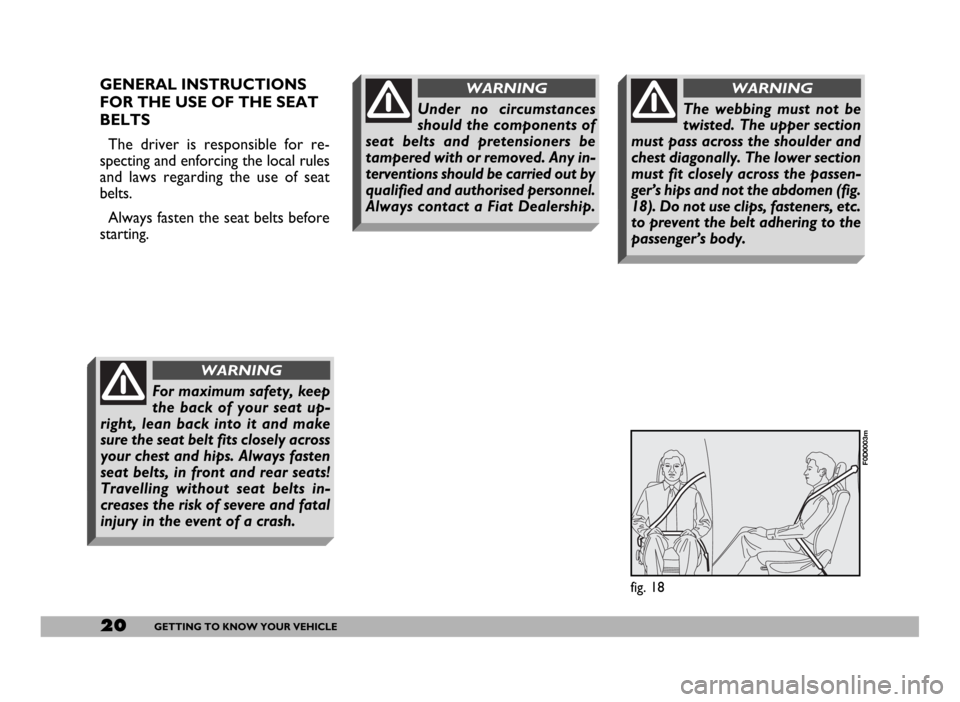
20GETTING TO KNOW YOUR VEHICLE
fig. 18
F0D0003m
The webbing must not be
twisted. The upper section
must pass across the shoulder and
chest diagonally. The lower section
must fit closely across the passen-
ger’s hips and not the abdomen (fig.
18). Do not use clips, fasteners, etc.
to prevent the belt adhering to the
passenger’s body.
WARNING
Under no circumstances
should the components of
seat belts and pretensioners be
tampered with or removed. Any in-
terventions should be carried out by
qualified and authorised personnel.
Always contact a Fiat Dealership.
WARNINGGENERAL INSTRUCTIONS
FOR THE USE OF THE SEAT
BELTS
The driver is responsible for re-
specting and enforcing the local rules
and laws regarding the use of seat
belts.
Always fasten the seat belts before
starting.
For maximum safety, keep
the back of your seat up-
right, lean back into it and make
sure the seat belt fits closely across
your chest and hips. Always fasten
seat belts, in front and rear seats!
Travelling without seat belts in-
creases the risk of severe and fatal
injury in the event of a crash.
WARNING
Page 22 of 258
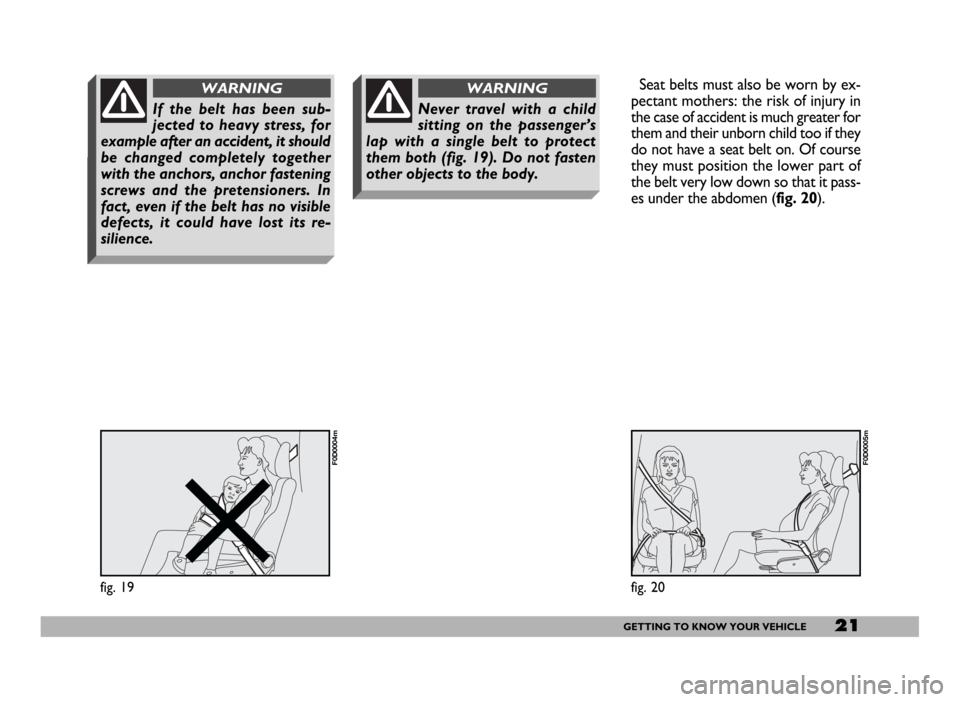
21GETTING TO KNOW YOUR VEHICLE
Seat belts must also be worn by ex-
pectant mothers: the risk of injury in
the case of accident is much greater for
them and their unborn child too if they
do not have a seat belt on. Of course
they must position the lower part of
the belt very low down so that it pass-
es under the abdomen (fig. 20).
fig. 19
F0D0004m
fig. 20
F0D0005m
If the belt has been sub-
jected to heavy stress, for
example after an accident, it should
be changed completely together
with the anchors, anchor fastening
screws and the pretensioners. In
fact, even if the belt has no visible
defects, it could have lost its re-
silience.
WARNING
Never travel with a child
sitting on the passenger’s
lap with a single belt to protect
them both (fig. 19). Do not fasten
other objects to the body.
WARNING
Page 23 of 258
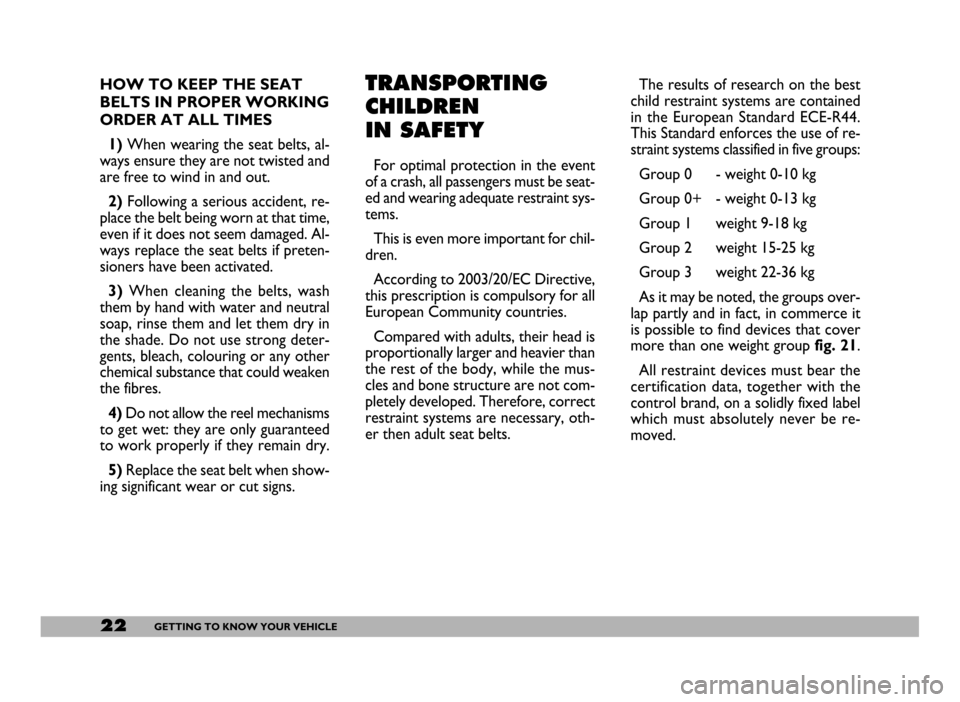
22GETTING TO KNOW YOUR VEHICLE
HOW TO KEEP THE SEAT
BELTS IN PROPER WORKING
ORDER AT ALL TIMES
1)When wearing the seat belts, al-
ways ensure they are not twisted and
are free to wind in and out.
2)Following a serious accident, re-
place the belt being worn at that time,
even if it does not seem damaged. Al-
ways replace the seat belts if preten-
sioners have been activated.
3)When cleaning the belts, wash
them by hand with water and neutral
soap, rinse them and let them dry in
the shade. Do not use strong deter-
gents, bleach, colouring or any other
chemical substance that could weaken
the fibres.
4)Do not allow the reel mechanisms
to get wet: they are only guaranteed
to work properly if they remain dry.
5)Replace the seat belt when show-
ing significant wear or cut signs.TRANSPORTING
CHILDREN
IN SAFETY
For optimal protection in the event
of a crash, all passengers must be seat-
ed and wearing adequate restraint sys-
tems.
This is even more important for chil-
dren.
According to 2003/20/EC Directive,
this prescription is compulsory for all
European Community countries.
Compared with adults, their head is
proportionally larger and heavier than
the rest of the body, while the mus-
cles and bone structure are not com-
pletely developed. Therefore, correct
restraint systems are necessary, oth-
er then adult seat belts.The results of research on the best
child restraint systems are contained
in the European Standard ECE-R44.
This Standard enforces the use of re-
straint systems classified in five groups:
Group 0 - weight 0-10 kg
Group 0+ - weight 0-13 kg
Group 1 weight 9-18 kg
Group 2 weight 15-25 kg
Group 3 weight 22-36 kg
As it may be noted, the groups over-
lap partly and in fact, in commerce it
is possible to find devices that cover
more than one weight group fig. 21.
All restraint devices must bear the
certification data, together with the
control brand, on a solidly fixed label
which must absolutely never be re-
moved.
Page 24 of 258
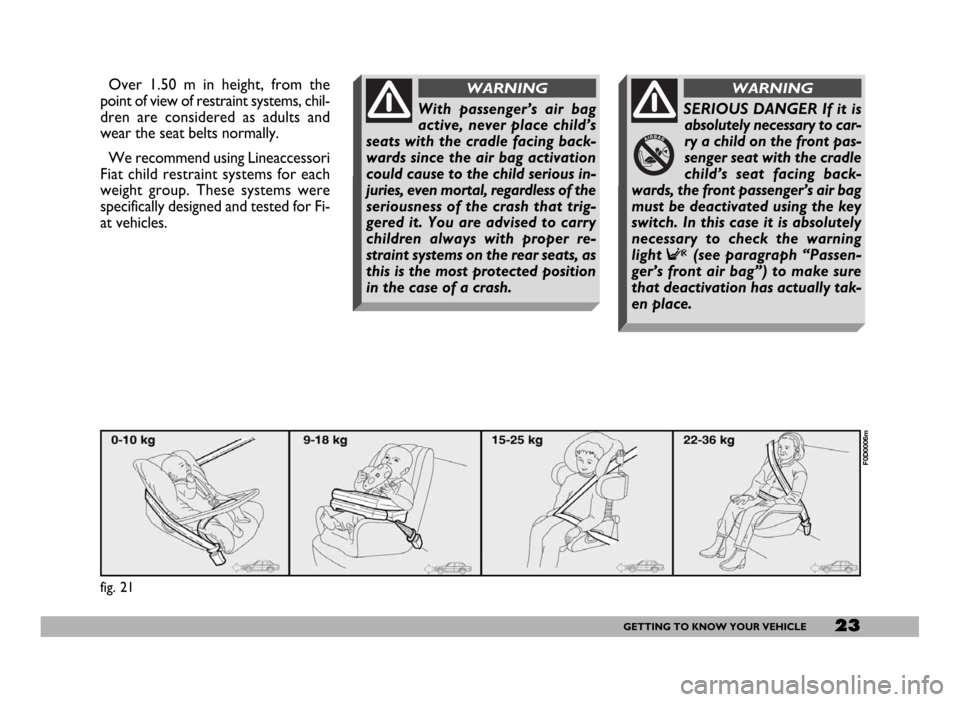
23GETTING TO KNOW YOUR VEHICLE
Over 1.50 m in height, from the
point of view of restraint systems, chil-
dren are considered as adults and
wear the seat belts normally.
We recommend using Lineaccessori
Fiat child restraint systems for each
weight group. These systems were
specifically designed and tested for Fi-
at vehicles.
fig. 21
F0D0006m
With passenger’s air bag
active, never place child’s
seats with the cradle facing back-
wards since the air bag activation
could cause to the child serious in-
juries, even mortal, regardless of the
seriousness of the crash that trig-
gered it. You are advised to carry
children always with proper re-
straint systems on the rear seats, as
this is the most protected position
in the case of a crash.
WARNING
SERIOUS DANGER If it is
absolutely necessary to car-
ry a child on the front pas-
senger seat with the cradle
child’s seat facing back-
wards, the front passenger’s air bag
must be deactivated using the key
switch. In this case it is absolutely
necessary to check the warning
light
F(see paragraph “Passen-
ger’s front air bag”) to make sure
that deactivation has actually tak-
en place.
WARNING
Page 25 of 258
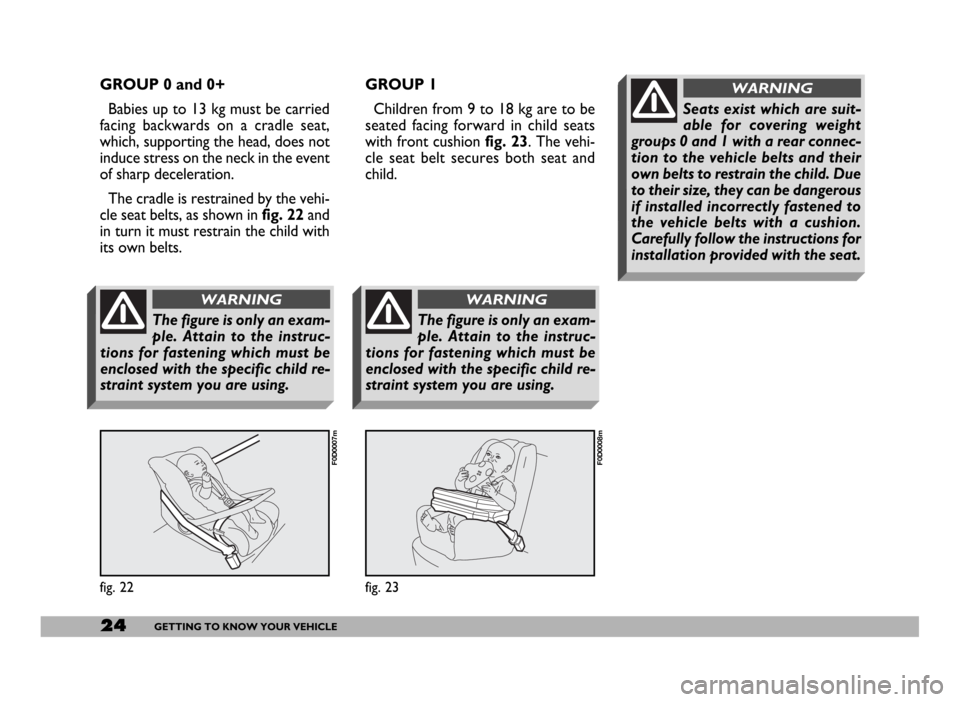
24GETTING TO KNOW YOUR VEHICLE
GROUP 0 and 0+
Babies up to 13 kg must be carried
facing backwards on a cradle seat,
which, supporting the head, does not
induce stress on the neck in the event
of sharp deceleration.
The cradle is restrained by the vehi-
cle seat belts, as shown infig. 22and
in turn it must restrain the child with
its own belts.GROUP 1
Children from 9 to 18 kg are to be
seated facing forward in child seats
with front cushionfig. 23. The vehi-
cle seat belt secures both seat and
child.
fig. 22
F0D0007m
fig. 23
F0D0008m
The figure is only an exam-
ple. Attain to the instruc-
tions for fastening which must be
enclosed with the specific child re-
straint system you are using.
WARNING
The figure is only an exam-
ple. Attain to the instruc-
tions for fastening which must be
enclosed with the specific child re-
straint system you are using.
WARNING
Seats exist which are suit-
able for covering weight
groups 0 and 1 with a rear connec-
tion to the vehicle belts and their
own belts to restrain the child. Due
to their size, they can be dangerous
if installed incorrectly fastened to
the vehicle belts with a cushion.
Carefully follow the instructions for
installation provided with the seat.
WARNING
Page 26 of 258
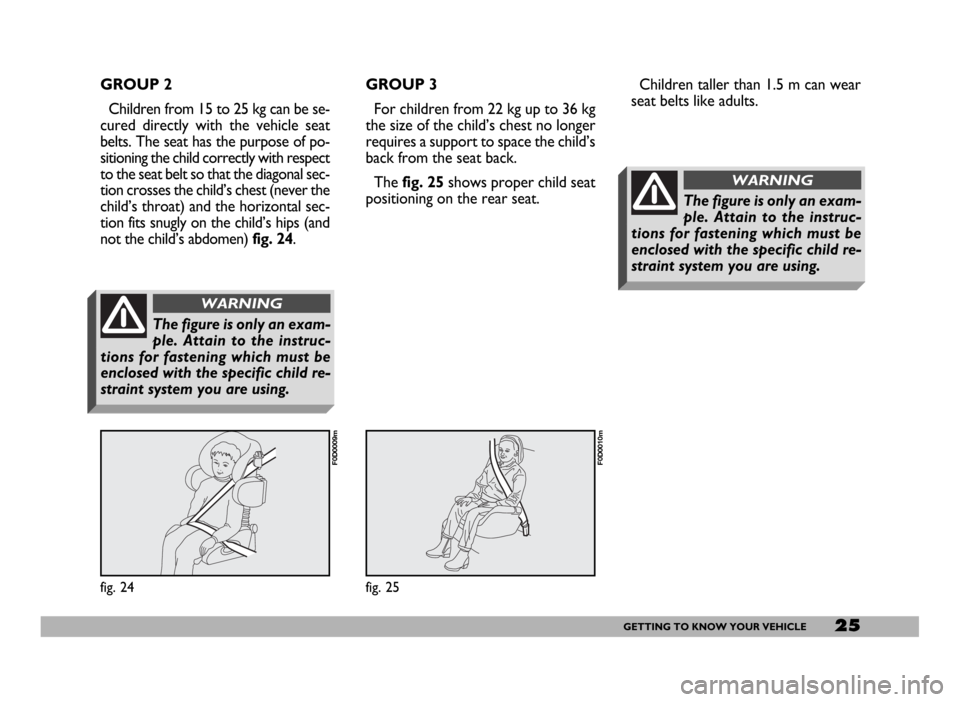
25GETTING TO KNOW YOUR VEHICLE
GROUP 2
Children from 15 to 25 kg can be se-
cured directly with the vehicle seat
belts. The seat has the purpose of po-
sitioning the child correctly with respect
to the seat belt so that the diagonal sec-
tion crosses the child’s chest (never the
child’s throat) and the horizontal sec-
tion fits snugly on the child’s hips (and
not the child’s abdomen) fig. 24.GROUP 3
For children from 22 kg up to 36 kg
the size of the child’s chest no longer
requires a support to space the child’s
back from the seat back.
The fig. 25shows proper child seat
positioning on the rear seat.
fig. 24
F0D0009m
fig. 25
F0D0010m
The figure is only an exam-
ple. Attain to the instruc-
tions for fastening which must be
enclosed with the specific child re-
straint system you are using.
WARNING
Children taller than 1.5 m can wear
seat belts like adults.
The figure is only an exam-
ple. Attain to the instruc-
tions for fastening which must be
enclosed with the specific child re-
straint system you are using.
WARNING
Page 27 of 258
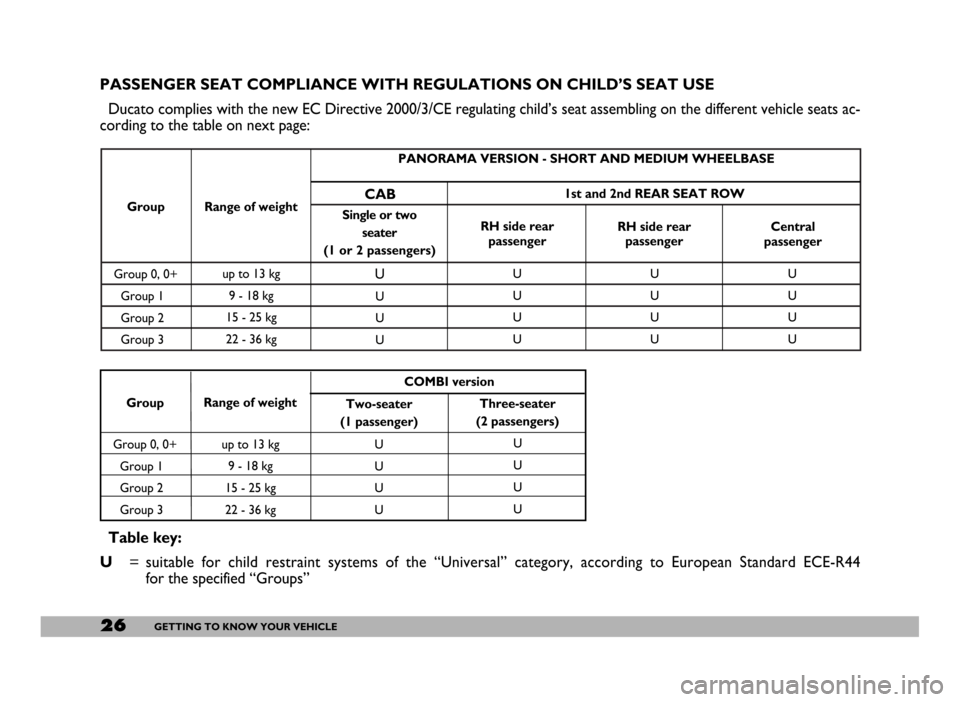
26GETTING TO KNOW YOUR VEHICLE
Group
Group Group 0, 0+
Group 1
Group 2
Group 3
Group 0, 0+
Group 1
Group 2
Group 3up to 13 kg
9 - 18 kg
15 - 25 kg
22 - 36 kg
up to 13 kg
9 - 18 kg
15 - 25 kg
22 - 36 kg
U
U
U
U
U
U
U
UU
U
U
U
U
U
U
UU
U
U
UU
U
U
U Range of weight
Range of weightSingle or two
seater
(1 or 2 passengers)
Two-seater
(1 passenger)RH side rear
passenger
Three-seater
(2 passengers)RH side rear
passengerCentral
passenger
COMBI version
PANORAMA VERSION - SHORT AND MEDIUM WHEELBASE
1st and 2nd REAR SEAT ROW
PASSENGER SEAT COMPLIANCE WITH REGULATIONS ON CHILD’S SEAT USE
Ducato complies with the new EC Directive 2000/3/CE regulating child’s seat assembling on the different vehicle seats ac-
cording to the table on next page:
Table key:
U= suitable for child restraint systems of the “Universal” category, according to European Standard ECE-R44
for the specified “Groups”
CAB
Page 28 of 258
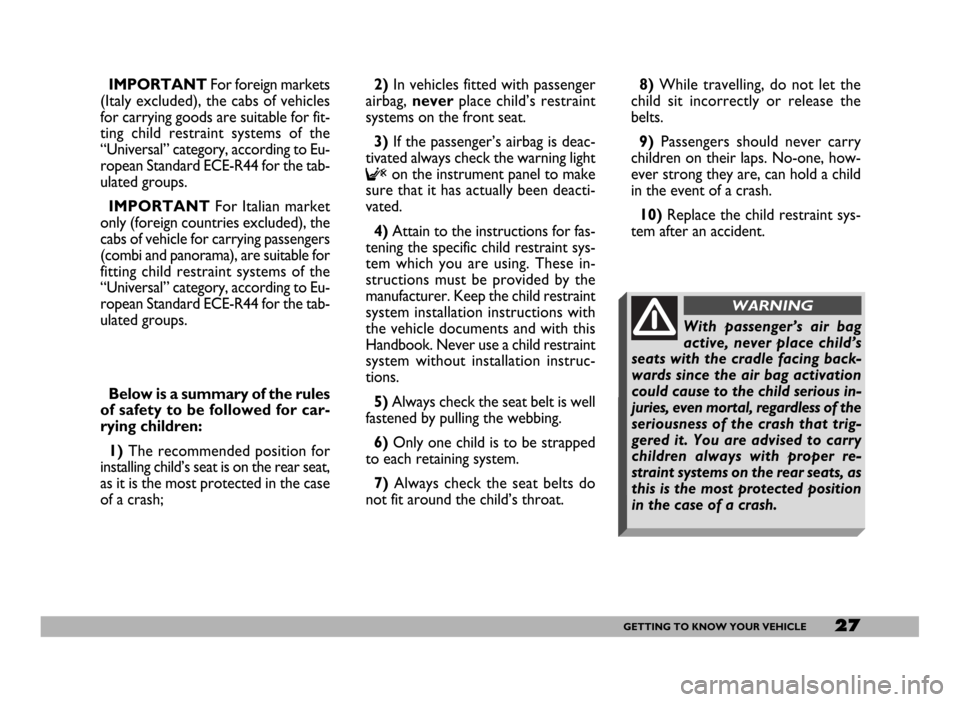
27GETTING TO KNOW YOUR VEHICLE
IMPORTANTFor foreign markets
(Italy excluded), the cabs of vehicles
for carrying goods are suitable for fit-
ting child restraint systems of the
“Universal” category, according to Eu-
ropean Standard ECE-R44 for the tab-
ulated groups.
IMPORTANTFor Italian market
only (foreign countries excluded), the
cabs of vehicle for carrying passengers
(combi and panorama), are suitable for
fitting child restraint systems of the
“Universal” category, according to Eu-
ropean Standard ECE-R44 for the tab-
ulated groups.
Below is a summary of the rules
of safety to be followed for car-
rying children:
1) The recommended position for
installing child’s seat is on the rear seat,
as it is the most protected in the case
of a crash;2) In vehicles fitted with passenger
airbag, neverplace child’s restraint
systems on the front seat.
3) If the passenger’s airbag is deac-
tivated always check the warning light
Fon the instrument panel to make
sure that it has actually been deacti-
vated.
4) Attain to the instructions for fas-
tening the specific child restraint sys-
tem which you are using. These in-
structions must be provided by the
manufacturer. Keep the child restraint
system installation instructions with
the vehicle documents and with this
Handbook. Never use a child restraint
system without installation instruc-
tions.
5) Always check the seat belt is well
fastened by pulling the webbing.
6) Only one child is to be strapped
to each retaining system.
7) Always check the seat belts do
not fit around the child’s throat.8) While travelling, do not let the
child sit incorrectly or release the
belts.
9)Passengers should never carry
children on their laps. No-one, how-
ever strong they are, can hold a child
in the event of a crash.
10) Replace the child restraint sys-
tem after an accident.
With passenger’s air bag
active, never place child’s
seats with the cradle facing back-
wards since the air bag activation
could cause to the child serious in-
juries, even mortal, regardless of the
seriousness of the crash that trig-
gered it. You are advised to carry
children always with proper re-
straint systems on the rear seats, as
this is the most protected position
in the case of a crash.
WARNING
Page 29 of 258

28GETTING TO KNOW YOUR VEHICLE
IGNITION SWITCH
The key can be turned to four dif-
ferent positions fig. 26.
STOP:engine off, key can be re-
moved, steering column locked.
MAR:drive position. All electrical
devices can be used.
AVV:to start the engine.
PARK:engine off, parking lights on,
key can be removed, steering column
locked. To turn the key to PARK,
press button A.STEERING COLUMN LOCK
To engage the lock: remove the ig-
nition key at STOPor PARK, and
turn the steering wheel until it locks.
To release the lock: rock the steer-
ing wheel slightly as you turn the igni-
tion key to MAR.
fig. 26
F0D0052m
If the ignition switch has
been tampered with (e.g.
someone has tried to steal your ve-
hicle), get a Fiat Dealership to make
sure it is still functioning properly
before you start driving again.
WARNING
When you get out of the
vehicle, always remove the
ignition key. This will prevent any-
one from accidentally working the
controls. Remember to apply the
handbrake and, if the vehicle is
faced up on a steep slope engage
the first gear. If it is facing down,
engage the reverse gear. Never
leave children in the vehicle by
themselves.
WARNING
Never remove the ignition
key while the vehicle is
moving. The steering wheel will au-
tomatically lock as soon as you try
to turn it. This also applies when
the vehicle is being towed.
WARNING
It is absolutely forbidden to
carry out whatever after-
market operation involving steering
system or steering column modifi-
cations (e.g.: installation of anti-
theft Device) that could badly af-
fect performance and safety, cause
the lapse of warranty and also re-
sult in non-compliance of the car
with homologation requirements.
WARNING
Page 30 of 258
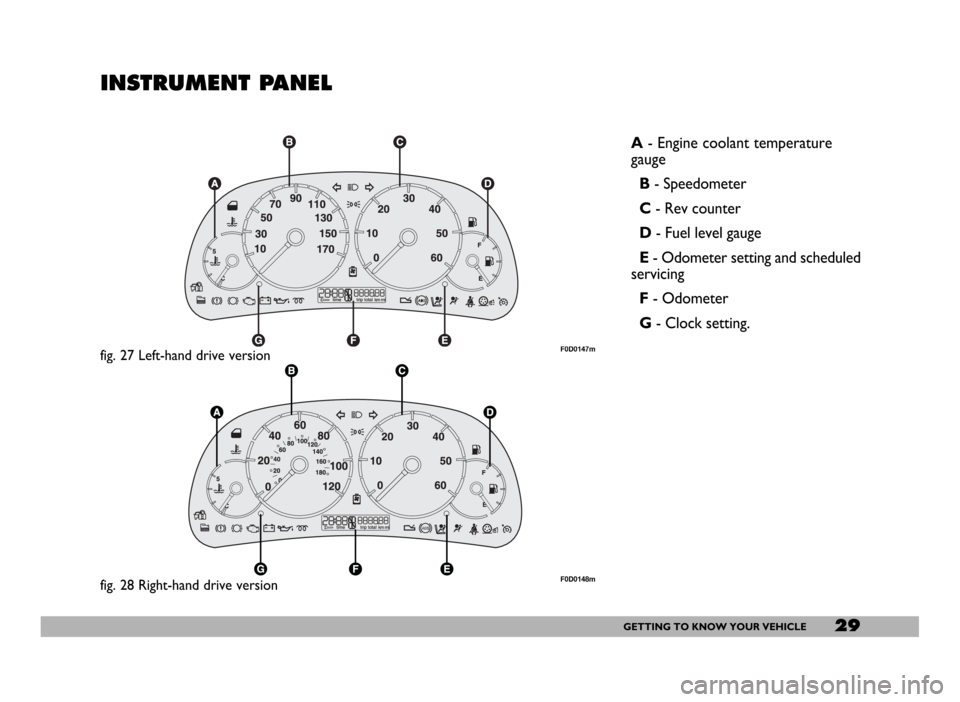
29GETTING TO KNOW YOUR VEHICLE
INSTRUMENT PANEL
A- Engine coolant temperature
gauge
B- Speedometer
C- Rev counter
D- Fuel level gauge
E- Odometer setting and scheduled
servicing
F- Odometer
G- Clock setting.
fig. 27 Left-hand drive versionF0D0147m
fig. 28 Right-hand drive versionF0D0148m